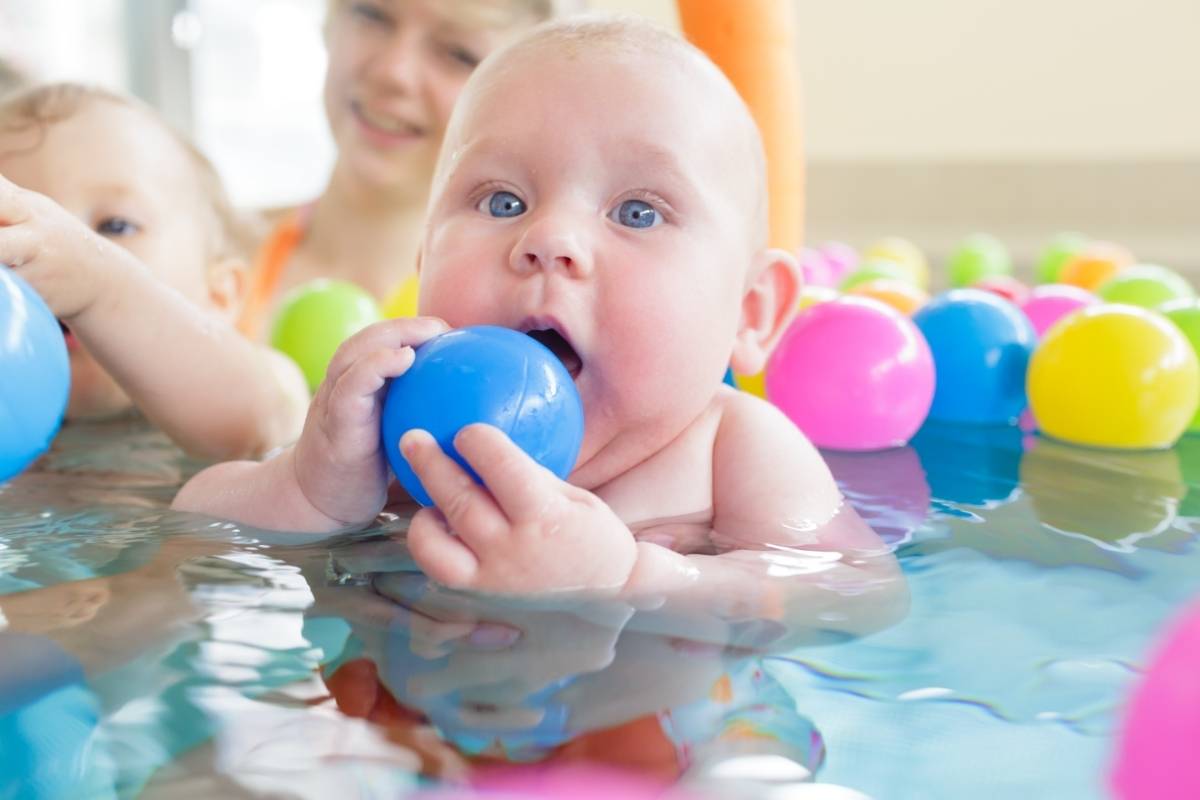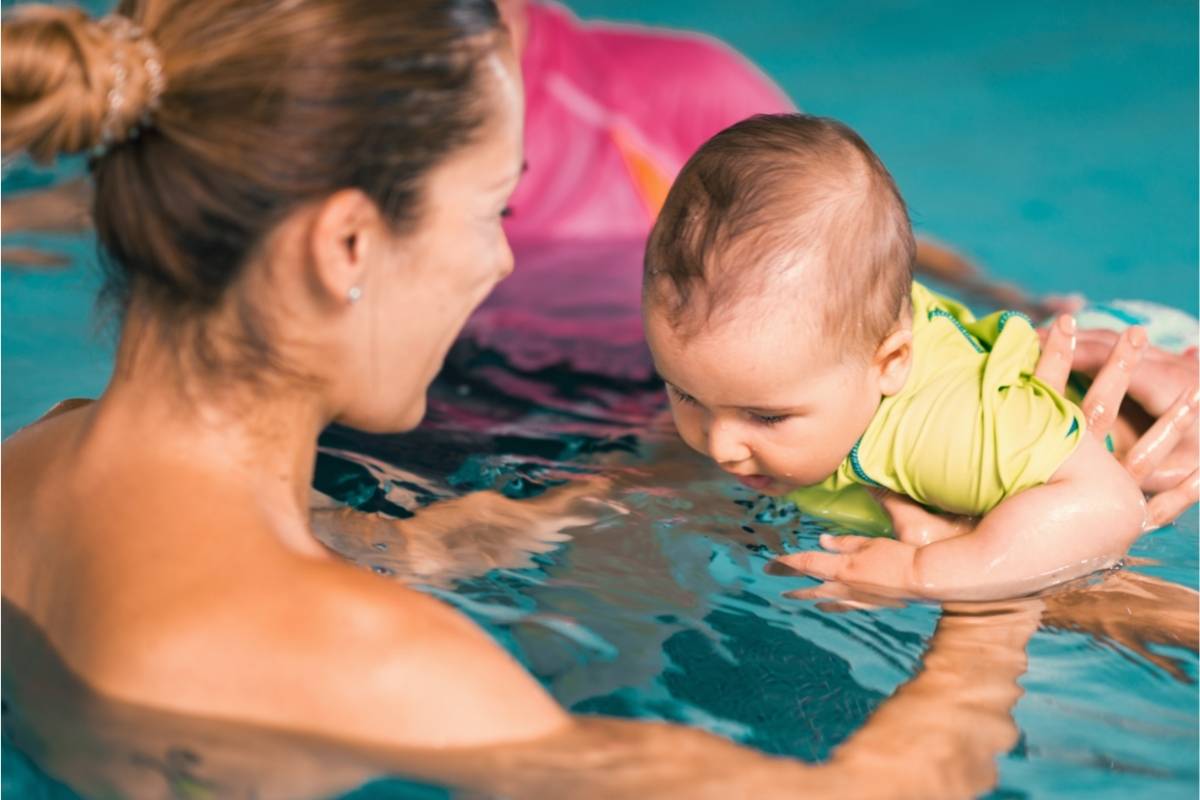From a parent’s perspective, there is a great deal of confusion around swimming classes. A lot of the reason for this is that they are designed for different goals. A parent might not be interested in letting a baby learn how to swim.
On the other hand, others might be interested in a class to help their baby develop a love for water and a sense of safety around water.
Taking your children to swimming lessons can also seem like a good plan, but are baby swimming classes worth it?
Here Is Why Baby Swimming Classes Are Worth It:
Baby swimming classes are worth it because your baby can get used to water early on and eventually learn how to swim.
You will also build a deeper bond with your baby because at first, your baby will be mostly dependent on you.
So it is an activity where it is just you and your child concentrating on one other during the session which is good for building a connection with your baby.
If you’re a parent wondering how useful swimming classes are, then you’ll find this article beneficial as it answers all questions you might have about baby swimming classes.
Read on to find out if these classes are worth it or not.

When Is The Best Age To Start Swimming Lessons For Your Baby?
Swim education for infants should begin when the youngster is approximately 6 months old, according to Goldberg.
She’s discovered that babies develop a fear of water around the age of eight months, so the sooner they become accustomed to being in it, the better off they will be.
However, don’t be concerned if you’ve missed the mark because they could learn later on.
Babies cannot swim by the time they are six months old. But they will gain some basic talents and comfort in the water, setting the framework for future success.
Nichole Steffens, aquatic product manager for the American Red Cross, says that infants who take part in parent-child aquatics gain knowledge and skills that will help them in future swimming lessons.
However, according to the American Academy of Pediatrics (AAP), babies can begin swimming classes from the age of one.
Previously, the organization had discouraged the participation of children under the age of four in swimming instruction.
Benefits Of Baby Swimming Classes
There are several benefits associated with teaching your baby how to swim.
Infants who take part in parent-child aquatics gain foundational knowledge and motor skills that will help them thrive in future swimming lessons and stay safer in and around water.
Develops The Child’s Brain
Bilateral cross-patterning motions, in which the baby uses both sides of the body, produce an action that aids in the development of your baby’s brain.
Cross-patterning movements generate neurons across the brain, with the corpus callosum being the most prominent location.
This builds everything from communication to feedback to modulation from one side of the brain to the other.
During swimming, your baby kicks his legs and moves his arms around. They’re doing it in water, which means their brain is picking up on both the physical sensation of the water and the resistance it provides them.
Brain development also contributes to language development, as well as reading abilities, better comprehension, and spatial awareness.
Muscular Development
The act of swimming helps develop important muscular control and growth at a young age.
When swimming, your baby has to learn to hold their head up, move their arms and legs, and work their core with the rest of their body.
This not only enhances their muscle strength and physical ability but also improves the rotation of their joints.
Swimming is also advantageous to your baby’s cardiovascular health as it improves your child’s heart, lungs, brain, and blood vessels.
Improves Their Self-Esteem
Swimming programs frequently include activities such as water play, singing, and skin-to-skin contact with parents or caregivers.
Children communicate with one another and with the instructor, and they begin to learn how to work in groups because of their experiences.
These aspects, as well as the pleasure derived from learning a new skill, may contribute to your child’s sense of self-worth, building their self-esteem.
Establishes A Connection Between You And Your Baby
Spending time in the water with your baby builds one-on-one bonding between them.
A swimming session is a terrific opportunity to spend quality time alone with your child because it is just you and your child concentrating on one other during the session.

How To Teach Your Child To Swim
Teaching your baby to swim is not as difficult as it might look; however, it isn’t as easy either. This is because it requires you to have a keen eye for attention to be able to monitor your child.
It also means that you have to be a good swimmer if you intend to teach your baby yourself.
Create A Comfortable Environment
The first thing you need to do when you are about to start teaching your baby how to swim is to make sure that the water is warm enough.
If the water is too cold, then your baby would find swimming very hard. You can use an electric heater or a gas heater to heat the water. The temperature of the water should be at least 35 degrees Celsius.
You must remember that babies cannot tolerate being in cold water. They would get sick if they are exposed to cold water for long periods.
Therefore, you must ensure that the water is warmed up before exposing your baby to it.
Use A Bathtub
Before rushing off to use the pool in your backyard, start with your bath. Your youngster can begin by studying in the bathtub.
Bathtub practice is even a better place to practice, as you can easily regulate and monitor your child, unlike a larger pool.
In a cool, clean pool of water, allow your baby to practice holding their breath and opening their eyes underwater while resting face-down.
Please, you should do this under close supervision. Remember, your baby is still new to the act and has no idea what is happening.
They get accustomed to the feeling with time, but for a first-timer, do not let your baby face down for more than a few seconds. It’s also possible for them to attempt floating on their backs and kicking their legs.
Fill the bathtub only to the point where their head rests on the tub’s bottom and their ears are covered in water to assist them in gaining confidence while floating on their backs in the bathtub.
As they get more expertise, you can raise the water level to accommodate them. To get better, you should help them practice constantly.
Even a little baby can be taught to grasp onto the pool’s edge or to roll onto his back to float if he or she receives regular instruction.
Where To Take Swimming Lessons
A simple google search like: ”baby swimming lessons near me” will reveal the different swimming pools near you where they provide baby swimming classes.
It’s a good idea to first take a trial lesson at two or three places to see which one you like best. If you’re in a small town there usually is only one place to take baby swimming classes.
In that case, you can just go for the one nearest to you.
Although most swim schools teach babies as young as six months old, the American Academy of Pediatrics (AAP) does not suggest formal programs until children are 12 months old since there is no evidence that they are beneficial.
You should decide whether to enroll a child in swim lessons depending on how frequently you expose your child to water. Your baby’s physical abilities, emotional, and health conditions.
You should also consider the fact that some public pools might contain chemicals that might be unhealthy for your baby’s skin.
If you’re going to take your child to a pool that is not within your home or leave them in the care of someone else, you should be sure they’ll be safe.
Ensure that the condition of the pool is suitable for your child’s tender skin, and the temperature is perfect for your swimming exercises.

